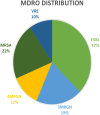Multidrug-resistant organisms (MDROs) in patients with subarachnoid hemorrhage (SAH)
- PMID: 33859304
- PMCID: PMC8050277
- DOI: 10.1038/s41598-021-87863-y
Multidrug-resistant organisms (MDROs) in patients with subarachnoid hemorrhage (SAH)
Abstract
Patient care in a neurointensive care unit (neuro-ICU) is challenging. Multidrug-resistant organisms (MDROs) are increasingly common in the routine clinical practice. We evaluated the impact of infection with MDROs on outcomes in patients with subarachnoid hemorrhage (SAH). A single-center retrospective analysis of SAH cases involving patients treated in the neuro-ICU was performed. The outcome was assessed 6 months after SAH using the modified Rankin Scale [mRS, favorable (0-2) and unfavorable (3-6)]. Data were compared by matched-pair analysis. Patient characteristics were well matched in the MDRO (n = 61) and control (n = 61) groups. In this center, one nurse was assigned to a two-bed room. If a MDRO was detected, the patient was isolated, and the nurse was assigned to the patient infected with the MDRO. In the MDRO group, 29 patients (48%) had a favorable outcome, while 25 patients (41%) in the control group had a favorable outcome; the difference was not significant (p > 0.05). Independent prognostic factors for unfavorable outcomes were worse status at admission (OR = 3.1), concomitant intracerebral hematoma (ICH) (OR = 3.7), and delayed cerebral ischemia (DCI) (OR = 6.8). Infection with MRDOs did not have a negative impact on the outcome in SAH patients. Slightly better outcomes were observed in SAH patients infected with MDROs, suggesting the benefit of individual care.
Conflict of interest statement
The authors declare no competing interests.
Figures

Similar articles
-
Rate and impact of multidrug-resistant organisms in patients with aneurysmal subarachnoid hemorrhage.Acta Neurochir (Wien). 2018 Oct;160(10):2049-2054. doi: 10.1007/s00701-018-3637-2. Epub 2018 Jul 25. Acta Neurochir (Wien). 2018. PMID: 30046875
-
Outcome after Hunt and Hess Grade V subarachnoid hemorrhage: a comparison of pre-coiling era (1980-1995) versus post-ISAT era (2005-2014).J Neurosurg. 2018 Jan;128(1):100-110. doi: 10.3171/2016.8.JNS161075. Epub 2017 Feb 24. J Neurosurg. 2018. PMID: 28298025
-
Multi-drug resistant organism infections in a medical ICU: Association to clinical features and impact upon outcome.Med Intensiva (Engl Ed). 2018 May;42(4):225-234. doi: 10.1016/j.medin.2017.07.006. Epub 2017 Oct 13. Med Intensiva (Engl Ed). 2018. PMID: 29033075 English, Spanish.
-
Risk of multi-drug-resistant organism acquisition from prior bed occupants in the intensive care unit: a meta-analysis.J Hosp Infect. 2023 Sep;139:44-55. doi: 10.1016/j.jhin.2023.06.020. Epub 2023 Jul 3. J Hosp Infect. 2023. PMID: 37406860 Review.
-
Effect of statin treatment on vasospasm-related morbidity and functional outcome in patients with aneurysmal subarachnoid hemorrhage: a systematic review and meta-analysis.J Neurosurg. 2017 Aug;127(2):291-301. doi: 10.3171/2016.5.JNS152900. Epub 2016 Oct 7. J Neurosurg. 2017. PMID: 27715439
Cited by
-
The Role of Nursing Care in the Management of Patients with Traumatic Subarachnoid Hemorrhage.Galen Med J. 2023 Aug 20;12:e3013. doi: 10.31661/gmj.v12i0.3013. eCollection 2023. Galen Med J. 2023. PMID: 38774855 Free PMC article.
-
Clinical epidemiology and case fatality due to antimicrobial resistance in Germany: a systematic review and meta-analysis, 1 January 2010 to 31 December 2021.Euro Surveill. 2023 May;28(20):2200672. doi: 10.2807/1560-7917.ES.2023.28.20.2200672. Euro Surveill. 2023. PMID: 37199987 Free PMC article.
-
Rate of Multidrug-resistance to Antimicrobial Drugs in Patients in Pediatric Neurointensive Care.Indian J Crit Care Med. 2023 Jan;27(1):67-72. doi: 10.5005/jp-journals-10071-24377. Indian J Crit Care Med. 2023. PMID: 36756473 Free PMC article.
-
Clinical risk factors for admission with Pseudomonas and multidrug-resistant Pseudomonas community-acquired pneumonia.Antimicrob Resist Infect Control. 2022 Jul 14;11(1):95. doi: 10.1186/s13756-022-01137-4. Antimicrob Resist Infect Control. 2022. PMID: 35836272 Free PMC article.
References
Publication types
MeSH terms
LinkOut - more resources
Full Text Sources
Other Literature Sources
Medical

